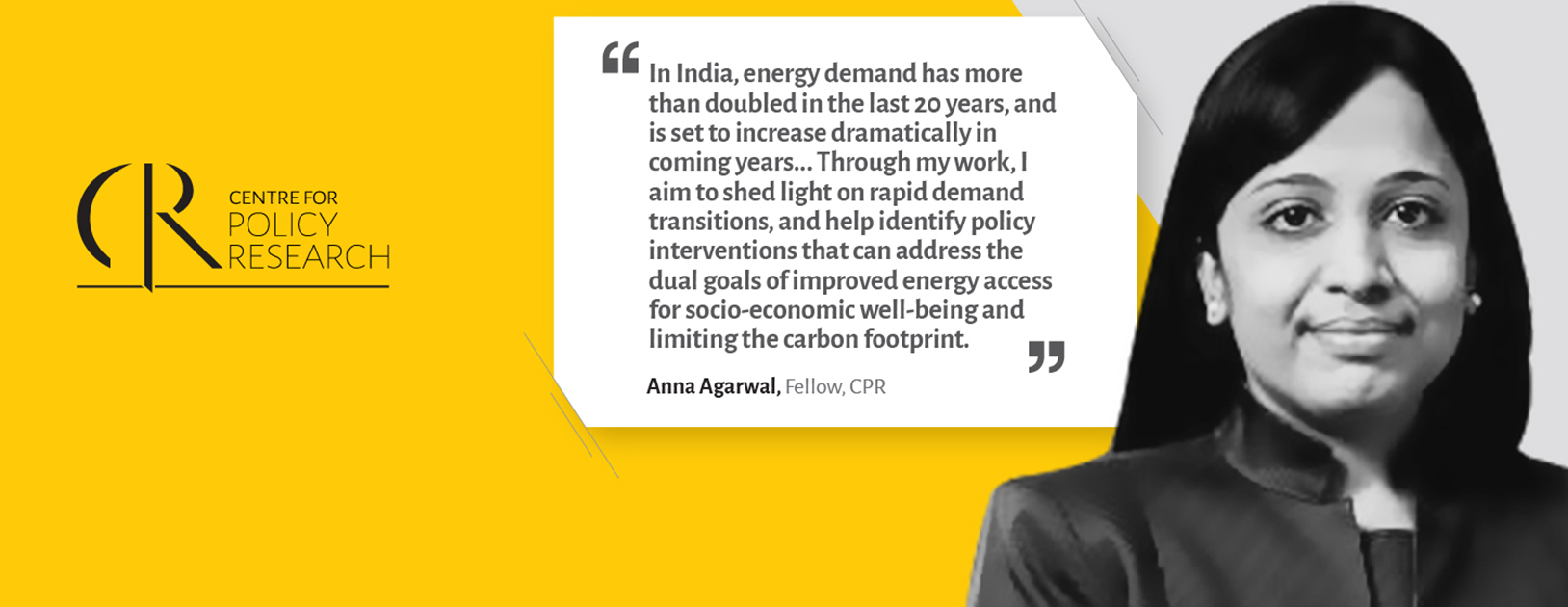
READ THE FULL INTERVIEW
CPR
Anna Agarwal is a Fellow at CPR, where she works on India’s energy demand patterns, and ways to lock-in a low-carbon energy trajectory. Her work currently focuses on residential electricity demand, particularly the cooling demand which would be a substantial driver of future energy needs and carbon emissions. To this end, she recently co-authored new research that answers a set of fundamental questions about energy-efficient cooling use in urban India.
Prior to joining CPR, she was at the Energy Policy Institute at the University of Chicago (India office). She has also held research appointments at the MIT Center for Energy and Environmental Policy Research, the MIT Energy Initiative, and the Energy and Power Division of the Planning Commission, Government of India. She holds a PhD and a SM degree from Massachusetts Institute of Technology, and an undergraduate degree from IIT Delhi.
In this edition of CPR Faculty Speak, Agarwal talks about her work and interests at CPR, why they matter, what impact she hopes to achieve and more.
Tell us about your research work and interests at CPR
My research looks at urban energy demand transitions in India, in particular how energy consumption is changing in urban households. Cooling-related energy demand – which will shape India’s future energy demand– is a key focus area of my work. More recently, I am also looking at how COVID-induced lifestyle changes, such as work from home, might affect long-term energy demand patterns.
Why does this issue interest you?
When we talk about decarbonising the energy sector to meet climate objectives, demand-side measures have not received the same level of attention as supply-side interventions. But demand-side efficiency measures can decarbonise at a lower cost, and have more co-benefits with development compared to supply side interventions. In India, it is even more important to focus on energy demand. With increasing summer temperatures, rapid urbanisation and rising incomes, changes in energy consumption will happen in a short window of time, so it is important to make consumption more efficient to lock-in a long-term low-carbon pathway.
How have these issues evolved in the country and globally over the years?
It is only recently that the global climate debate has recognised the importance of complementing supply-side energy interventions with demand-side efficiency measures. In India, energy demand has more than doubled in the last twenty years, and is set to increase dramatically in coming years. Cooling energy demand is expected to be fifteen times by 2050 – making India the world’s largest energy user for cooling, as per the International Energy Agency. This huge growth in energy demand will come at the cost of a substantial increase in carbon dioxide emissions.
What impact do you aim to achieve through your research?
Through my work, I aim to shed light on rapid demand transitions, and help identify policy interventions that can address the dual goals of improved energy access for socio-economic well-being and limiting the carbon footprint.
What are you currently working on and why is it important?
We are analysing findings from a 2000-household survey done in Delhi to understand cooling practices and their transitions. Our recently published paper in Environmental Research Letters explores the ‘what, why, and how of changing cooling energy consumption in India’s urban households.’ We are now working on a second research paper based on the same dataset.
We are also working on understanding the role that smart meters can play in managing residential electricity demand. India is planning to do a massive rollout of smart meters with the goal of replacing 25 crore conventional meters with smart meters. Smart meters monitor real-time electricity consumption, and present a unique opportunity to get accurate estimates on household electricity demand profile. This can aid the distribution companies in designing targeted demand management programs, such as time-of-use tariffs to reduce peak demand. Also, access to systematic real-time data on electricity consumption could help households make energy-efficient consumption decisions.
What does a typical day look like for you at CPR?
The majority of my time is spent on research, which would be a mix of office work and field work, depending on the nature of the ongoing project. A typical day at CPR – in a ‘typical’ time – would also have a couple of meetings, which mostly tend to occur in smaller groups to discuss work, with larger group meetings once or twice a week. I also sometimes attend or participate in panel discussions and roundtables hosted by CPR or external groups. What I miss most during these pandemic times is the many short conversations that we would have with colleagues through the day over coffee and lunch.
To know more about Anna Agarwal’s work and research, click here.


